During the last Ice Age most of Canada and the northern United States would have been covered in a sheet of ice while the American southwest would have been lush, wet, and cool. A far cry from the comparatively hot, dry, and parched land of the modern southwest. It was the warming climate at the end of the Ice Age that would alter much of the southwest but small islands of temperate climates and rich biodiversity are still present in high elevation mountain ranges and wetlands. Living in these scattered oases are a variety of now geographically isolated plants and animals that are intimately tied to these places. Unique to these locations, and found nowhere else in the world, they have evolved into distinct species from fragmented populations of organisms that during the Ice Age would have been far more widespread.

One of these species is the Apache trout (Oncorhynchus apache), one of at least 59 distinct species, subspecies, and populations of native western trout. Many of them are found only in a single small locale that continues to provide them with what they need, while the greater habitat around them grows increasingly inhospitable. The Apache trout is the state fish of Arizona and one of only two species of native trout found in the state.
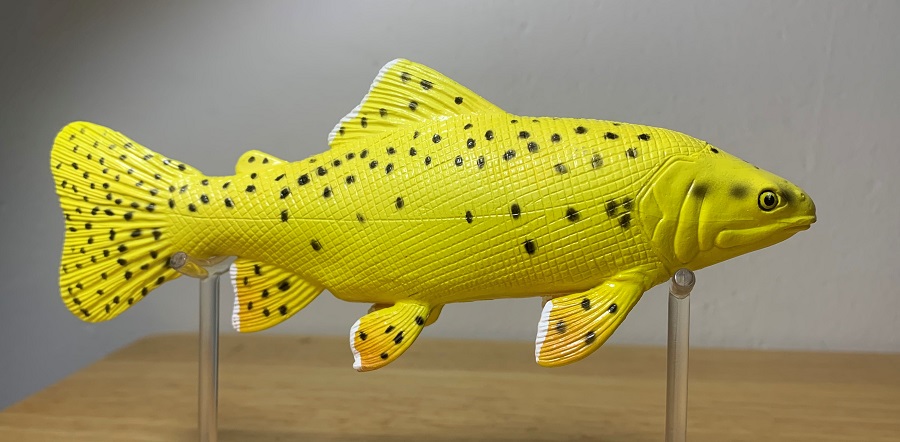
The Apache trout is native to the watersheds of the Black and White Rivers and the upper Little Colorado River watershed of the White Mountains. Totaled together, the Apache trout’s range would have consisted of about 600 miles of water (970 km) during the 19th century. Today its native range is smaller, although the Apache trout has been introduced to other isolated high elevation streams and lakes. The species is listed as critically endangered and is at risk of extinction due to hybridization with non-native rainbow trout, competition with non-native brook and brown trout, climate change, and habitat degradation.
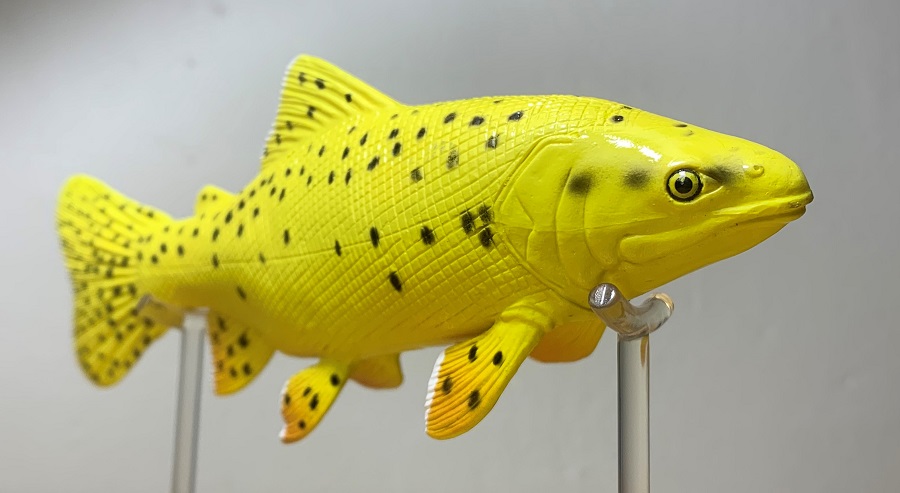
Today we’re looking at the Safari Ltd. Apache trout, commissioned by the Marsh and Associates Native Fish Lab in Arizona. It is one of a set of 6 endangered fishes of the American southwest. Like all the Marsh and Associates fishes this Apache trout measures 6” (15 cm) so they are not in scale with each other. Thanks to the limited space and resources of its native environment the actual Apache trout only averages about 5-10” (13-13 cm), making this toy 1/1 in scale for an average fish. Stocked Apache trout in lakes can grow larger, with a maximum length of 24” (60 cm).
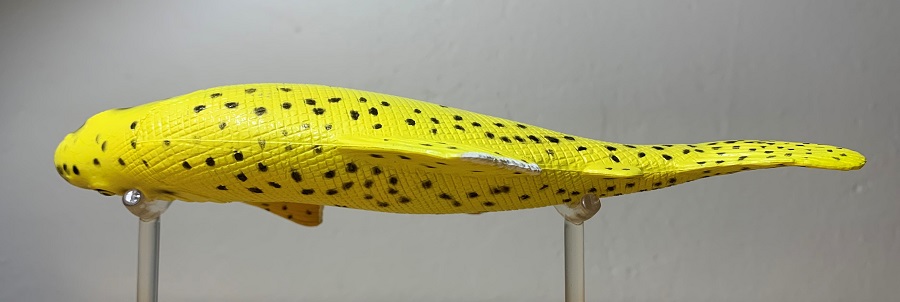
The Safari Apache trout is detailed with cross-hatched scales, sculpted fin rays, a lateral line, and fine detailing around the lips and operculum. It faithfully recreates the typical trout body plan, including the fleshy little adipose fin behind the dorsal fin. The body rests on its pectoral and pelvic fins and is sculpted in a gentle S shape with the head veering leftward and the tail rightward.

The toy is a solid canary yellow color and although the actual Apache trout could be described as being yellow in color it is far more muted than this, with a blending of dark olive-green dorsal colors that fade to paler yellow coloration along the flanks and belly. Other figures in the set, like the previously reviewed pikeminnow and razorback, execute this blending of light and dark colors to decent effect but there is no attempt to do that here.
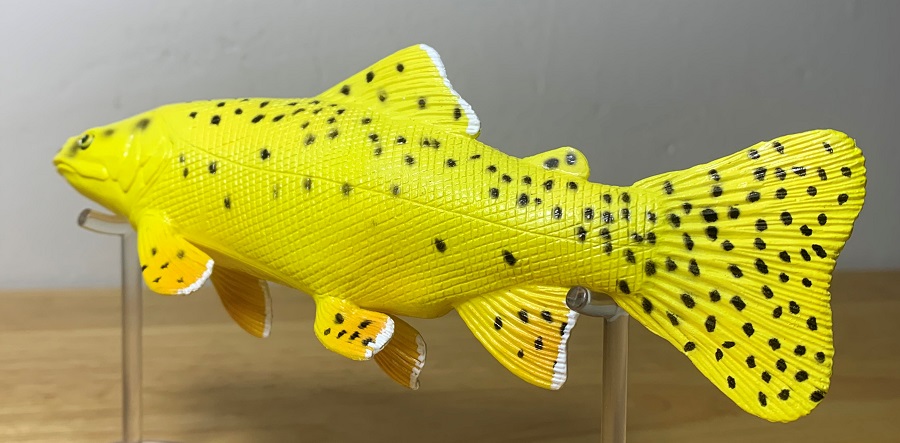
Black spots are painted across the body, mostly above the lateral line and on the fins. The spots are large and evenly spaced like they would be in life. The pectoral, pelvic, and anal fins are tipped in orange and along with the dorsal fin, edged in white. Pure Apache trout have a dark spot on either side of their pupil which creates a black stripe through the eye. That feature is not displayed here. Hybrid and hatchery bred Apache trout often lack the eye stripe, but I would prefer it if the toy mimicked the pure wild Apache trout more closely.
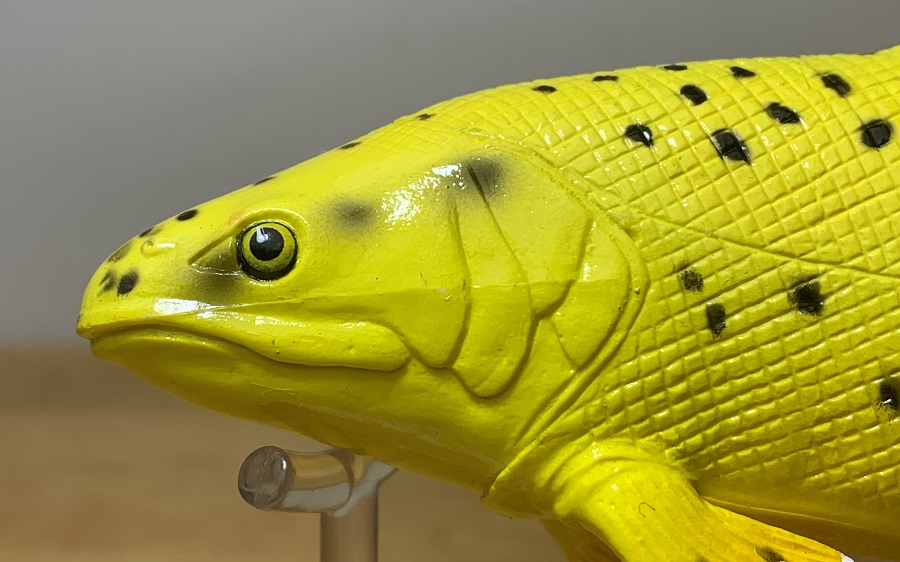
Although I would have appreciated a more accurate paint job, I’m not about to scoff at any plastic reproduction of a trout that’s as obscure and rare as an Apache trout. I might consider it the weakest figure in the set but the set itself is without compare and would be incomplete without the Apache trout. In this hobby even figures of common salmonids are rare, you have to take what you can get. Despite its flaws this is still one of the best trout figures ever produced in plastic. The Safari Ltd. Apache trout is only available on the Marsh Education website and retails for $12.99.
Disclaimer: links to Ebay and Amazon on the AnimalToyBlog are affiliate links, so we make a small commission if you use them. Thanks for supporting us!




Wonderful review, as always! And I agree, the paint on this figure could have been better executed. When you see the six fish side-by-side, this one just jumps out with this bright, less-than-realistic yellow!
I was excited to recently acquire the entire Marsh Fish set. While bigger than I would normally like, there are just some sets that a generalist must complete, this being one of them. And hey, it’s the state fish of my home state :).
…oh, and I can’t help but notice two of our last three reviews were yellow fish with black spots 😀
I seriously debated even getting the Apache trout but the set would be incomplete without it, and this is such a unique set that it needs to be complete. I’m happy to have it now, of course.
I noticed that the last 6 reviews have NOT been of a tetrapod.